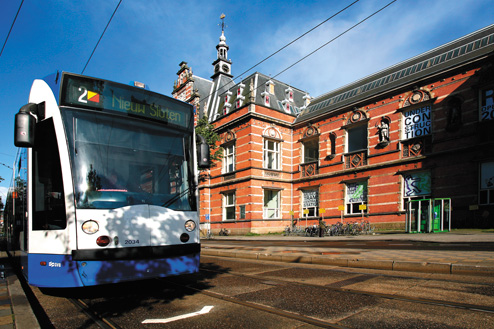Geography
Located in western Europe on the North Sea and bordered by France and Germany, the Kingdom of the Netherlands is unique in being so man-made. Only 4% of the country is in its 'natural' state and 20% has been reclaimed from the sea. 'While God created the earth, the Dutch created the Netherlands', goes the old saying and the landscape remains in a constant state of flux. The battles with water – a quarter of the country lies below sea level – have shaped the Dutch psyche.
The country comprises 41,526 square kilometres, of which 33,783 is land and 7,760 water. East to west (Enschede to Amsterdam) it measures 161 kilometres; north to south (Groningen to Maastricht) 348 kilometres. Sixteen million people on such a small piece of land (470 people per square kilometre) make the Netherlands the most densely populated country in Europe. People are concentrated in the cities of what is known as the Randstad – a region encompassing the provinces of North and South Holland and Utrecht. No Dutch city has yet accumulated a million inhabitants, and each has retained its unique character and architectural style.
The very neat and orderly landscape is achieved through an extensive consultation and planning process (very Dutch). Its flatness is almost unremitting - Nederland in Dutch literally translates as 'lowland'. But there are actually a few 'hills' in Limburg in the south-east, and the country's highest point is at Vaalserberg, 321 metres above sea level. Within the 13 provinces, some variety can be found in the forests of the Veluwe and the moorland in Drenthe. The Wadden Islands boast 451 kilometres of dune-filled wet and windy coastline, stretching across the north of the country. There are twenty National Parks, which are areas of outstanding beauty. Throughout the Netherlands are thousands of polders (areas of reclaimed land) surrounded by dykes (the barriers around them which keep out the water). The country's famous canals drain any water which does seep past the dykes back out to sea. This aquatic know-how derives from when windmills (such a powerful symbol of Holland) revolutionised the way water was drained from the land during the 14th century.
The country comprises 41,526 square kilometres, of which 33,783 is land and 7,760 water. East to west (Enschede to Amsterdam) it measures 161 kilometres; north to south (Groningen to Maastricht) 348 kilometres. Sixteen million people on such a small piece of land (470 people per square kilometre) make the Netherlands the most densely populated country in Europe. People are concentrated in the cities of what is known as the Randstad – a region encompassing the provinces of North and South Holland and Utrecht. No Dutch city has yet accumulated a million inhabitants, and each has retained its unique character and architectural style.
The very neat and orderly landscape is achieved through an extensive consultation and planning process (very Dutch). Its flatness is almost unremitting - Nederland in Dutch literally translates as 'lowland'. But there are actually a few 'hills' in Limburg in the south-east, and the country's highest point is at Vaalserberg, 321 metres above sea level. Within the 13 provinces, some variety can be found in the forests of the Veluwe and the moorland in Drenthe. The Wadden Islands boast 451 kilometres of dune-filled wet and windy coastline, stretching across the north of the country. There are twenty National Parks, which are areas of outstanding beauty. Throughout the Netherlands are thousands of polders (areas of reclaimed land) surrounded by dykes (the barriers around them which keep out the water). The country's famous canals drain any water which does seep past the dykes back out to sea. This aquatic know-how derives from when windmills (such a powerful symbol of Holland) revolutionised the way water was drained from the land during the 14th century.


-2.jpg)










